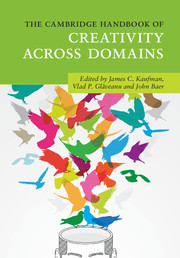Book contents
- The Cambridge Handbook of Creativity Across Domains
- The Cambridge Handbook of Creativity Across Domains
- Copyright page
- Dedication
- Contents
- Figures
- Tables
- Contributors
- Acknowledgments
- Part I Creativity and Domain
- Part II Creativity in the Traditional Arts
- Part III Creativity in the Sciences
- Part IV Creativity in Business
- 18 Studying Creativity across Different Domains
- 19 The Relationship Between Marketing and Creativity
- 20 Creative Leadership
- 21 Creativity in Business and Technology
- 22 Creativity in Design
- 23 A Minimalist Model for Measuring Entrepreneurial Creativity
- Part V Newer Domains for Creativity Research
- Part VI Creativity in Everyday Life
- Part VII Conclusion
- Index
- References
19 - The Relationship Between Marketing and Creativity
It’s Complicated
from Part IV - Creativity in Business
Published online by Cambridge University Press: 15 September 2017
- The Cambridge Handbook of Creativity Across Domains
- The Cambridge Handbook of Creativity Across Domains
- Copyright page
- Dedication
- Contents
- Figures
- Tables
- Contributors
- Acknowledgments
- Part I Creativity and Domain
- Part II Creativity in the Traditional Arts
- Part III Creativity in the Sciences
- Part IV Creativity in Business
- 18 Studying Creativity across Different Domains
- 19 The Relationship Between Marketing and Creativity
- 20 Creative Leadership
- 21 Creativity in Business and Technology
- 22 Creativity in Design
- 23 A Minimalist Model for Measuring Entrepreneurial Creativity
- Part V Newer Domains for Creativity Research
- Part VI Creativity in Everyday Life
- Part VII Conclusion
- Index
- References
Summary
In this chapter, we explore the role of creativity in marketing, and suggest that a better understanding of creativity in the marketing domain can yield unique insights for research in both creativity and marketing. We first discuss the definitions of the concept of creativity in marketing and marketing research, and its relation to other associated constructs. Second, we focus on three core domains of application for creativity in marketing: operational, strategic, and organizational. Third, we shift to consumer creativity and offer a critical overview of some of the methodological aspects of creativity research in marketing. Finally we discuss our findings and introduce key questions to be addressed in future research in the field.
- Type
- Chapter
- Information
- The Cambridge Handbook of Creativity across Domains , pp. 345 - 362Publisher: Cambridge University PressPrint publication year: 2017



